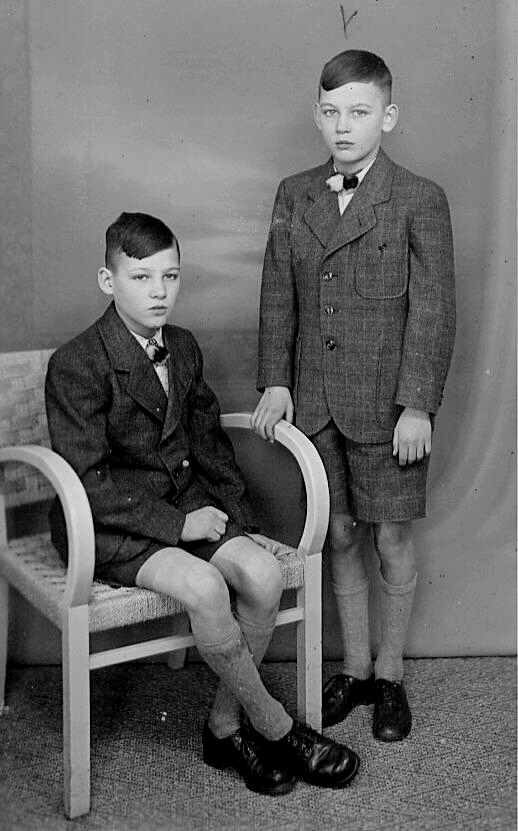
German Boys' Clothes: Suit Chronology--20th Century

Figure 1.--German boys commonly wore knee pants or short pants suits in the first half of the 20th century, but by the 1960s long pants began to become increasingly common. At the same time we see boys increasingly wearing more casual clothes rather than suits. These brothers wear similar single-breasted acket suits, but with different patterns. The portrait is undated. We are not sure, but would guess that it was taken in the 1930s. The "X" abovethe boy at right oprobbly means that he died during the War.
|
|
Suits were still commonly worn by German boys in the first half of the 20th century. The styles were much more uniform than in the 9th century as most were mass produced in the ready-war trade. Younger boys in the very early 20th century wore collar-buttoning jackets. We also see single- and double breasted dack suits. These became the dominant style after Wotld War I. Boys commonly wore knee pants in the early-20th century, but short pants became more common after the War. Older boys might wrar knickers. Afyter Wirld War II, short pants were still common. Wearing suits declined sharply in popularity during the 1950s. And by the 1960s more boys were wearing long pnts, especially with suits. By the late 20th century, suits were only worn for formal occassions and almost always with long psnys, except for very young boys.
The 1900s
Norfolk styling for suits was very popular after the turn of the 20th century.
Younger German boys wore a variey of different suit styles in the 1910s. The suits worn by younger boys were much more diverse than those worn by older boys and men. We note many charming portraits of Germany boys dressed in a wide aray of differet suit styles for their first day of school. We see many boys wearing sailor suits rather than types of sack suits. Collar-butoning suits jackets were also very common. Younger boys mostly wore knee pans suits, but we see some suits done with bloomer knickers. Older boys were more likely to wear sack suits with lapels. We see both single and double breasted jackets. Some have a rather modern look. Norfol styling was poplar. We see both knee pants and long pants suits. Here age was the principal factor, but conventins varied from family to family. Boys often got a more adult-looking suit for his confirmation at about age 13 years. We note relativey small lepels in the 1910s. Many of these suits, however, were done with knee pants. Knicker suits were not very common.
Collar-buttoning jackets went out of style for boys' suits by the 1920s. We mostly see single-breasted suits, but there were some double-breasted suits as well. Norfolk styling continued to be popular in the 1920s, but was going out of style by the end of the decade. An option for boys and even younger teenagers were sailor suits. Many boys continued wore open-collar Schiller collars rather than ties with suits during the 1920s. After World War I, short pants became increasingly common, but knee pants were also still common. Most boys and younger teenagers wore either short pants or knicker suits. Knickers suits were not very common for boys. Teenagers might wear knicker suits by their mid-teens and then long pants suits by their late teens. The precise timing of these shifts varies from family to damily. Knickers might be worn with knee socks, but long stockings were common with short pants. The choice of hosiery varied from family to family and depended on age, sason, and formality.
The 1930s
Suits were still commonly wirn by German boys in the 1930s. Suit sutyles had become more standardized by the 30s. Boys still wre sailor suits until about age 13. Most suits were dacks suits with lapels.
We note that by the 1930s that some boys had begin to wear casual jackets rather than suit coats. Neckwar varied Also we note boys wearing open necked shirts rather than ties with their suits. Ties wre cimmn for formal occassins. We commonly see neck ties, but there were several other options. Norfolk styling was declining in popularity. We note both single- and double-breated jackets. The boys here wear identical single-breasted suit, although with different fabric done in different patterns (figure 1). Their lapels are cut a ittle higher than moder suit jackets. Most boys wore short pants suits. Tennagers at about 15 began wearing long pants suits, although some boyswire knicker suits rather than long pants suits.
The 1940s
After World War II (1939-45), short pants suits were still common.
The 1950s
The 1960s
German boys commonly wore knee pants or short pants suits in the first half of the 20th century, but by the 1960s long pants began to become increasingly common. At the same time we see boys increasingly wearing more casual clothes rather than suits.
German boys by 1960s many boys began wearing long pants suits, but suits were becoming less common--reserved parimarily for special occassions.
The 1970s
HBC

Navigate the Boys' Historical Clothing German pages:
[Main German suit chronology page]
[German choirs]
[German scouts]
[Hitler Youth]
[German school uniforms]
[German royalty]
[German sailor suits]
[Lederhosen]
[Ethnic]
[Tights]
[Long stockings]
Navigate the Boys' Historical Clothing Web Site:
[Introduction]
[Activities]
[Biographies]
[Chronology]
[Clothing styles]
[Countries]
[Topics]
[Bibliographies]
[Contributions]
[FAQs]
[Glossaries]
[Images]
[Links]
[Registration]
[Tools]
[Boys' Clothing Home]
Created: 12:45 AM 1/27/2009
Last updated: 3:17 AM 8/19/2010



